We’ve finally had relief from the prolonged dry weather, though extended periods of rain bring their own potential problems as prolonged leaf wetness is often a key factor in plant diseases taking hold.
I haven’t had any questions about early blight yet, but I anticipate that people will be noticing it soon, if they haven’t already.
Farmers around the mid-coast region, and the western lakes and mountains region, are starting to see brassica plants that look suspiciously like they may have swede midge damage, though none have been positively identified yet, as far as I know. This new pest may have already spread more widely in Maine they we previously thought. Please familiarize yourself with what the damage from this pest can look like – catching it early and preventing large population growth is critical to avoid severe damage from this tricky new pest.
Alicyn Smart from the UMaine Plant Disease Diagnostic Lab let me know that she’s seen a lot of garlic samples coming in to the lab with Botrytis rot (Botrytis porri, description from last year’s report here). The recent weather has been ideal for botrytis, so now is the time to scout your garlic and send in suspicious samples to the lab for testing – especially if you plan to sell seed garlic. Remember to verify that any variety of seed garlic you purchase comes from a crop that has been tested for bloat nematode and other persistent diseases. This can be done by requesting a seller share the diagnostic report of the bloat nematode test for a particular variety.
Another garlic issue has been popping up to our south and west, which is “news to me”: anthracnose of garlic scapes (Colletotrichum fioriniae). David Fuller, of UMaine Extension, said that he’s only seen it in Maine once previously. Let us know if you see any on garlic in Maine (though I expect most folks have removed scapes already). If you also grow celery, it may be worth checking your garlic field even if it has already been de-scaped.
I’m seeing tarnished plant bugs all over my own garden. I’m also getting photos sent to me of four lined plant bug feeding damage, which can look alarmingly like a disease.
Consider this a very early warning that basil downy mildew has been found in northern New Jersey. It’s not quite close enough to be concerning for us here in Maine yet, but who knows what the next two weeks of weather between now and the next Pest Report may bring.
Mexican bean beetles have been reported in Massachusetts, so if you’ve had problems with them previously consider ordering bio-control before it’s too late.
Early Blight
Swede Midge
Anthracnose of Garlic Scapes
Tarnished Plant Bug & Four Lined Plant Bug
Basil Downy Mildew
Mexican Bean Beetle
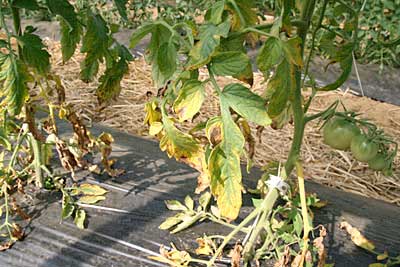 |
| Early blight on tomato |
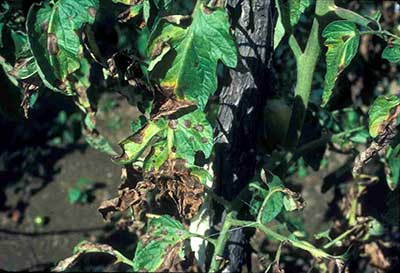 |
| Another view of early blight on tomato |
EARLY BLIGHT ON TOMATO (Alternaria)
By Eric Sideman
Early blight is a serious problem in tomatoes and potatoes, but rarely affects peppers and eggplants. In most years, it is very common; much more common than late blight, which is usually rare in Maine.
All aboveground portions of the plant can be affected throughout the growing season. The disease starts on the lower leaves with small, circular spots with concentric rings that resemble a target. Leaves develop yellow blighted areas, eventually turn all yellow and die. The tomato fruit may rot on the stem end. Though rare, potato tubers can also become infected.
The pathogen overwinters on diseased plant residues in the soil. Initial infection is from splashing up from this overwintering site. However, by mid-summer, most of the infection is coming from spores blowing in the wind from the widespread infection in gardens and on farms across the region.
It is important to avoid early on-set of the disease because the longer you can avoid the problem the more likely it is that you will harvest red tomatoes before the plants die.
Here are some cultural practices that can help avoid this disease:
- Use crop rotations of at least three years to non-hosts (i.e., away from tomato, potato, and eggplant). Once the plant residue decays, the pathogen is gone.
- Provide optimum growing conditions and fertility. Stressed plants (including drought or excessive moisture or shade) are more susceptible to early blight.
- Stake or cage plants to keep fruit and foliage away from soil, and promote quicker drying.
- Drip irrigation is preferred. If using overhead irrigation, start before dawn, so plants are dry early in the day. The key is to keep the period of leaf wetness to a minimum.
- Mulching helps to prevent splashing of spores from soil up to lower leaves.
- Indeterminate tomato and late-maturing potato varieties are usually more resistant or tolerant to early blight.
- Each season, disinfect stakes with an approved product before use. Sodium hypochlorite at 0.5% is effective and must be followed by rinsing and proper disposal of solution. Hydrogen peroxide is also permitted.
- Grow tomatoes in a high tunnel or caterpillar tunnel. Tomatoes grown with such protection rarely suffer from early blight because there is less splashing up from the soil and fewer wind-blown spores, and the leaves remain drier.
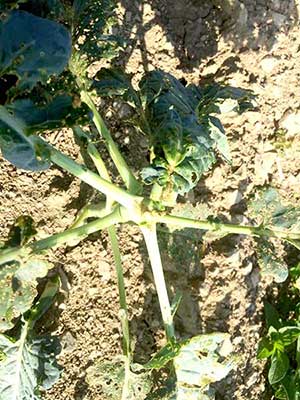 |
| Blind head of broccoli; characteristic damage of swede midge |
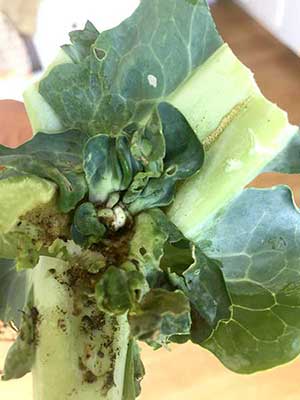 |
| Cauliflower with swede midge damage |
SWEDE MIDGE (Contarinia nasturtii)
The swede midge is a relatively new invasive pest that has been spreading south and east from where it was first found in Canada in 2000. These tiny midges are weak fliers, but they can do a lot of damage to brassica crops when they get established and their populations build up. Adults lay their eggs near the growth points of brassica crops and the hatched larvae (maggots) feed on the growing tip of the plant. Because of this, damage is most severe in heading crops (broccoli, cabbage, cauliflower, etc).
The larvae of this midge are very small and hard to find, tucked away in the plant’s growth point. That means that scarring and warped growth from earlier feeding is likely to be the first indication you will find of this new invader. The feeding damage can disfigure new leaf growth, and as few as one individual at the wrong time can cause total loss of the primary saleable portion of heading crops.
After feeding on the plants, larvae then drop to the top layers of the soil to pupate, and later emerge as adults to repeat the cycle on other plants. There may be as many as five generations per year.
Because the larvae are the only stage in the life cycle to damage the plant, growers often do not notice the damage until the swede midge larvae have already left the plant. Damage to the apical meristem (the growth point where broccoli heads, etc, are eventually formed) is irreversible. Side shoots often develop their own small heads after damage to the apical meristem.
Because of the nature of the damage, the nature of different crop architecture, as well as some crop preference on behalf of the midges, some crops are better suited for tolerating swede midge damage than others. Most susceptible are broccoli, cauliflower, collards and kohlrabi. Least susceptible are turnips and greens like bok choi or mizuna. In the middle of that range is cabbage, brussels sprouts, and kales. Anecdotally, ‘Red Russian’ kale types seem to be the most susceptible, while ‘Lacinato’ types (aka ‘Toscano’, ‘Dinosaur Kale’) seem to be the least susceptible, or perhaps simply the least attractive to the midge.
If you notice swede midge damage in your fall brassicas, it would be prudent to assume that there will be pupae overwintering in that soil.
Organic control options are limited – the protection of the plant’s overlapping leaves around the growing point shield swede midge from insecticides that would otherwise kill it, and row cover or exclusion netting is effective only if the midge are not already present in the soil as overwintered pupae.
Elisabeth Hodgdon at Cornell Cooperative Extension reports that some farm trials found good protection with regular sprays of spinosad (Entrust) and kaolin clay (Surround) under a 2ee label in New York, but only when swede midge populations were small. With large populations, no OMRI listed products were found to be effective. If hoping to pursue a spray program for control, check material label instructions carefully (the label is the law), and clarify with the Maine Board of Pesticides Control if you have any questions.
The best recommendations as of now aren’t drastically different than what many farmers currently do: utilizing exclusion starting at transplanting or direct seeding (row cover or netting like 25g ProtekNet), combined with crop rotations that are as long and distant as possible (3+ years and ideally more than 1,000 feet apart – over half a mile is best). Swede midge can also survive and reproduce on brassica weeds (yellow rocket, wild mustard, pennycress, shepherd’s purse, etc.), so brassica weed presence also needs to be taken into account for each field being utilized in a rotation.
Some other management options being explored include pheromone mating disruption (confusing male adults with large doses of pheromones), essential oil products like Garlic Barrier which has shown marginal efficacy but little residual effect, and perhaps most promising – spring tarping over infested ground, which may prevent overwintered midges from successfully emerging as adults.
Please feel encouraged to send photos of unexplained damage in your brassica crops.
More information and photos can be found in the spring 2020 edition of the Maine Organic Farmer & Gardener and from the swede midge information center website.
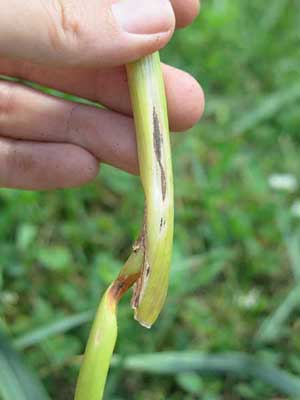 |
| Anthracnose on garlic scape. Photo Olivia Saunders UNH Extension |
ANTHRACNOSE ON GARLIC SCAPES (Colletotrichum fioriniae)
The fungus pathogen that is responsible for anthracnose on garlic scapes (Colletotrichum fioriniae), is the same fungus that causes celery anthracnose – described in the pest report last year. Because of this, one theory for the sudden appearance of the disease, is that it is spreading from celery crop debris to garlic. However, the fungus can potentially infect several crops including cherry tomatoes, blueberries and strawberries, and it can infect many common weeds like lambsquarters, pigweed, nutsedge, oakleaf goosefoot, groundsel and even poison ivy. Before we celebrate any possibility that it will inhibit weeds – make note that it can infect them asymptomatically.
When infecting garlic, anthracnose first appears as tan sunken lesions up to an inch long, which then turn orange as the fungus produces spores. Apparently some growers in New York state refer to it as “orange fuzzy scape” though it’s been noted that the sporulation is more gooey than fuzzy. Twelve hours of wetness is thought to be required for the fungus to successfully infect the plant, but longer periods of freely available water may allow a larger outbreak.
It is thought that only scapes and bulbils will usually show signs of infection, so spread by seed cloves is unlikely, though anyone propagating garlic by bulbil should take this disease into consideration.
Because the disease primarily affects scapes, economic damage to the bulb crop is unlikely. However, the disease can survive on crop debris in the soil for several years, so it is most likely worth removing infected scapes from the field as part of your regular de-scaping. Similarly, if you grow celery, you should probably be checking for this disease and considering a copper fungicide or bio-fungicide plan to protect your celery from infection. It is not yet clear how easily the disease moves from garlic to celery, or vice versa, but it is probably best to plan on long rotations between the two crops, when possible.
See this brief write-up from Meg McGrath, Cornell Cooperative Extension, for more information and some vibrant orange fungi photos.
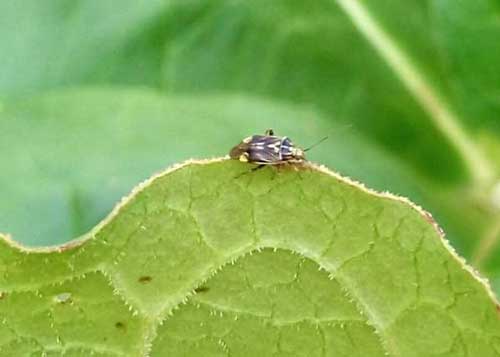 |
| Tarnished plant bug adult |
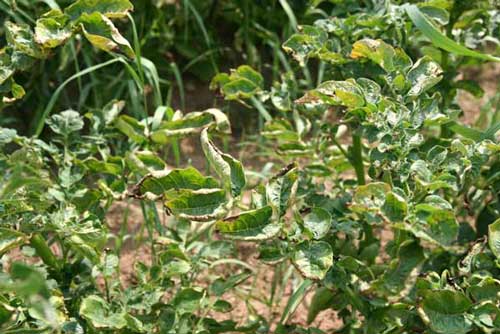 |
| Tarnished plant bug damage |
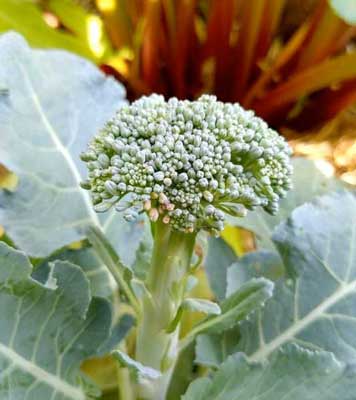 |
| Brown beading on broccoli from tarnished plant bug feeding |
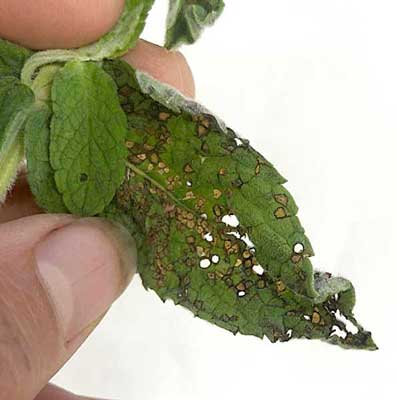 |
| Probable four lined plant bug feeding damage on a mint. Photo Katheryn Langelier |
TARNISHED PLANT BUG & FOUR LINED PLANT BUG
The tarnished plant bug looks to become rampant this year. It is a small (6 mm), bronze, brown and black bug that feeds on a very wide variety of plants (up to 300 different species). They overwinter as adults under debris and become active early in the spring. The population size explodes in fields of hay. When the hay is cut the critters fly in search of food and end up on fruit and vegetables. There are three or more generations per season.
They are serious pests on strawberries (causing cat faced berries), lettuce (browning of midrib), celery (causing scars on the petiole), flowers (destroying buds), eggplant and pepper (destroying buds so there is no fruit), broccoli (brown beads in the head), and much more. In potato they basically kill flowers (who cares?) and damage some of the leaflets (minor problem). But the browning leaflets sometimes concern folks that fear it may be late blight.
Four lined plant bugs and their management are similar to tarnished plant bugs, though their adult form stands out and is more easily spotted, as they are yellow with four black stripes – somewhat similar in appearance to striped cucumber beetles (which also seem to be rampant this year). Four lined plant bugs also feed on a very wide variety of plant species, and particularly like the mint family. Their feeding damage causes round sunken dead spots on a leaf, that may eventually become see-through, or even fall out of the leaf, leaving a round hole. Because they create many of these spots in the same area as they feed, it can often look alarmingly like a foliar disease.
For more information on four lined plant bugs, and good photos of both the bugs and their damage, look here.
Both bugs may be killed by pyrethrum (Pyganic), but often it is not worth it because their numbers are so great in all the fields of hay, and in the weeds surrounding you, that what you kill will be replaced in a day or two. Beyond using row cover to exclude them, weeding and nearby field management is about all you can do to keep the numbers low. If you choose to use pyrethrum, you may find best results if you follow it as soon as possible with row cover or exclusion netting to keep out the next batch headed your way.
BASIL DOWNY MILDEW (Peronospora belbahrii)
It is a little early in the season to be mentioning this problem, but it was recently found in northern New Jersey so let’s be careful. Seedlings that are already infected with basil downy mildew are sometimes sold (which is how it was found in New Jersey this year), and so it is possible that gardeners all over can introduce the pathogen to their fields. The extent of the spread will depend on weather conditions. Be on the lookout if you purchase seedlings.
This is a relatively new problem, and it can be widespread. Downy mildew of basil was first reported in Uganda back in 1930. Recently it has been getting lots of attention as it spreads, first to Italy in 2004, France in 2005, United States (Florida) in 2007 and by 2009 New England.
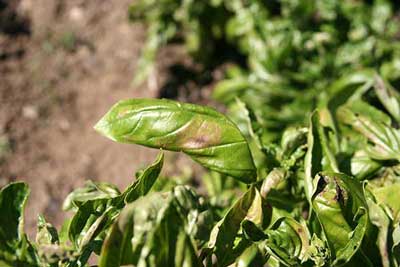 |
| Basil downy mildew |
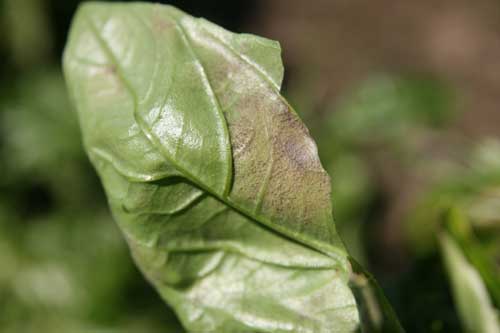 |
| Downy mildew spores on bottom of basil leaf |
The first symptom is a pale yellowing of the upper surface of the leaves, quite similar to sunscald. Later, vein-bounded patches of dark spore production can be seen on the lower surface. This develops into a gray, fuzzy growth typical of downy mildews of other crops. At first you may be able to convince yourself that some soil has been splashed onto the underside of the leaf, but soon the plants will be going down and it will be clear that it is not a problem that can be washed away.
The disease may be seedborne, but that is probably a very rare event. The spread is most likely due to the wind-blown spores. In the damp conditions of the early and mid-summer they could move far and wide. There is also some belief that seedlings already infected and moved across country for sale play a role.
The infected leaves are safe to eat, and reports from growers are that mildly infected leaves still make a fine tasting pesto. Some types of basil are less or not susceptible at all. For example, Thai basil is almost always fine. At least one grower reports that lemon basil is not susceptible, and that the purple basil seems a bit less susceptible.
The common sweet basil is the most susceptible. Several new varieties have been developed by Rutgers University, with strong downy mildew resistance (DMR), but not complete immunity. Growers have reported that these varieties can hold out against the disease an extra 2 weeks compared to non-resistant varieties. Varieties include ‘Obsession DMR’, ‘Devotion DMR’, ‘Thunderstruck DMR’ and ‘Passion DMR’. If you see downy mildew on any variety that you are growing, make pesto fast.
Anything that will allow leaves to dry quickly will help, e.g., weed control, good spacing, venting tunnels, watering in the morning instead of the evening, etc. One strategy is to make new plantings every 3-4 weeks in hopes that if the spores come in and infect one planting it can be destroyed it so it does not release spores, and there will be another planting waiting in the wings. Some growers have claimed that they caught symptoms early, cut plants back hard before a stretch of sunny dry weather, removing all leaves (critical to the success of this approach), and that later regrowth avoided infection as there were no infected living leaves to act as a source of inoculum. It’s worth a shot (time to make pesto anyway, right?) but not a plan to be relied on as foolproof.
You can continue to track the spread of the disease this season with the basil downy mildew monitoring map here.
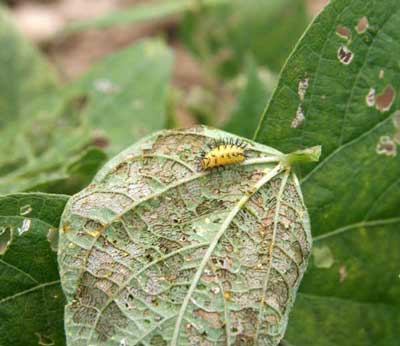 |
| Mexican bean beetle larva |
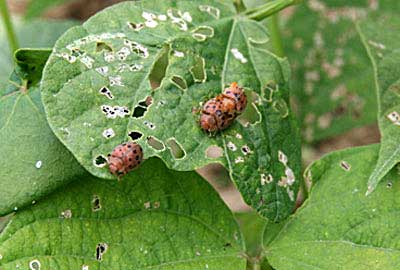 |
| Mexican bean beetle adults |
MEXICAN BEAN BEETLE – Plan Ahead for Biological Control
(Reprinted and modified from Mass. Veg. Notes, written by Ruth Hazzard and A. Brown)
If Mexican bean beetles have historically been a problem on your farm, you will very likely see them again this year. They may be pests on snap beans, soybeans, and lima beans.
While they are not a pest on every farm, some farms report repeated significant damage from these pests and have to take action to prevent crop loss. Using biological control can reduce the need for insecticides.
Mexican bean beetle (MBB) adults are coppery brown with black spots. They look very much like large ladybeetles and in fact are closely related – but unlike lady beetles they feed on leaves, not other insects. Adults lay yellow-orange egg masses on the underside of bean leaves. These hatch into bright yellow, spiny oval larvae, which feed, molt several times as they grow, and pupate on the underside of leaves. Feeding damage from adults and larvae can reduce yield and injure pods if numbers are high. There are several generations per season, often with increasing populations in each generation.
Pediobius foveolatus is a commercially available biological control agentfor Mexican bean beetle control and has a good track record in the mid-Atlantic states and among New England growers who have tried it. (Pediobius is pronounced “pee-dee-OH-bee-us”). It is mass-reared and sold by the New Jersey Dept of Agriculture and is also available from other beneficial insect suppliers. This small (1-3 mm), non-stinging parasitic wasp lays its eggs in Mexican bean beetle larvae. Wasp larvae feed inside the MBB larva, kill it, and pupate inside it, forming a brownish case or ‘mummy’. About twenty five adult wasps emerge from one mummy. Control continues and in fact gets better as the season progresses and successive generations of the wasp emerge and search out new bean beetle larvae.
Planning 2-3 releases at 7-10 day intervals will help ensure good timing. and coverage on several plantings. This makes it well suited to our succession-planted snap bean crops. After a release in the first plants, it is advisable to leave that planting intact for a while, until the new generation of wasps has emerged from their mummies. As with any biological control, make releases as soon as the pest is present – not after it has built up to damaging numbers. The New Jersey Dept. of Agriculture Beneficial Insect Rearing Laboratory recommends two releases, two weeks in a row, coinciding with the beginning of Mexican bean beetle egg hatch. Wasps will lay their eggs in larvae of any size, but it is best to target the newly-hatched young MBB larvae. This will give control before damage has been done. Thus, timing is important. Watch for eggs and time the shipment for the first hatch of eggs into larvae. If in doubt about the timing of the hatch, release as soon as you see the eggs – if you wait for the larvae you may be playing catch-up. The release rate should be at least 2000 adult wasps per field for less than an acre, or 3,000 per acre for fields of one acre or more.
Pediobius wasps are shipped as adults or ‘mummies’ (pupal parasites inside dead MBB larvae) from which about 500 adults will emerge. Order adults if you already have MBB larvae in the field. Ship for overnight delivery. Instructions for handling and release will come with the wasps. Wasps reproduce in the field and will still be around when the second generation of MBB hatches out. Thus, it should not be necessary to make more than two releases. Like beans, Pediobius wasps are killed by frost.
Plan ahead by contacting a supplier to inform them of your expected release dates and acreage. Contact information for New Jersey source:
Wayne Hudson, 609-203-9782, [email protected], NJDA, Phillip Alampi Insect Lab, W. Trenton, NJ 08628. https://nj.gov/agriculture/divisions/pi/prog/beneficialinsect.html. You’ll also get advice on how to use the wasps from this office.
Pediobius is also available from:
ARBICO organics, AZ, 800 -827-2847. Order online; orders ship on Wednesdays ONLY, minimum 7 day processing.
IPM Laboratories, NY, 315-497-2063. Contact to check availability
Beneficial Insectary Inc., CA, 800-477-3715.
Materials Approved for Organic Production
Moderate control can be achieved with spinosad (Entrust) as well as mixtures of pyrethrin (Pyganic EC5.0) and azadirachtin (Neemix, for example).

This material is based upon work supported by the National Institute of Food and Agriculture, U.S. Department of Agriculture, through the Northeast Sustainable Agriculture Research and Education program under subaward number ONE19-334.
Any opinions, findings, conclusions, or recommendations expressed in this publication are those of the author(s) and do not necessarily reflect the view of the U.S. Department of Agriculture.
